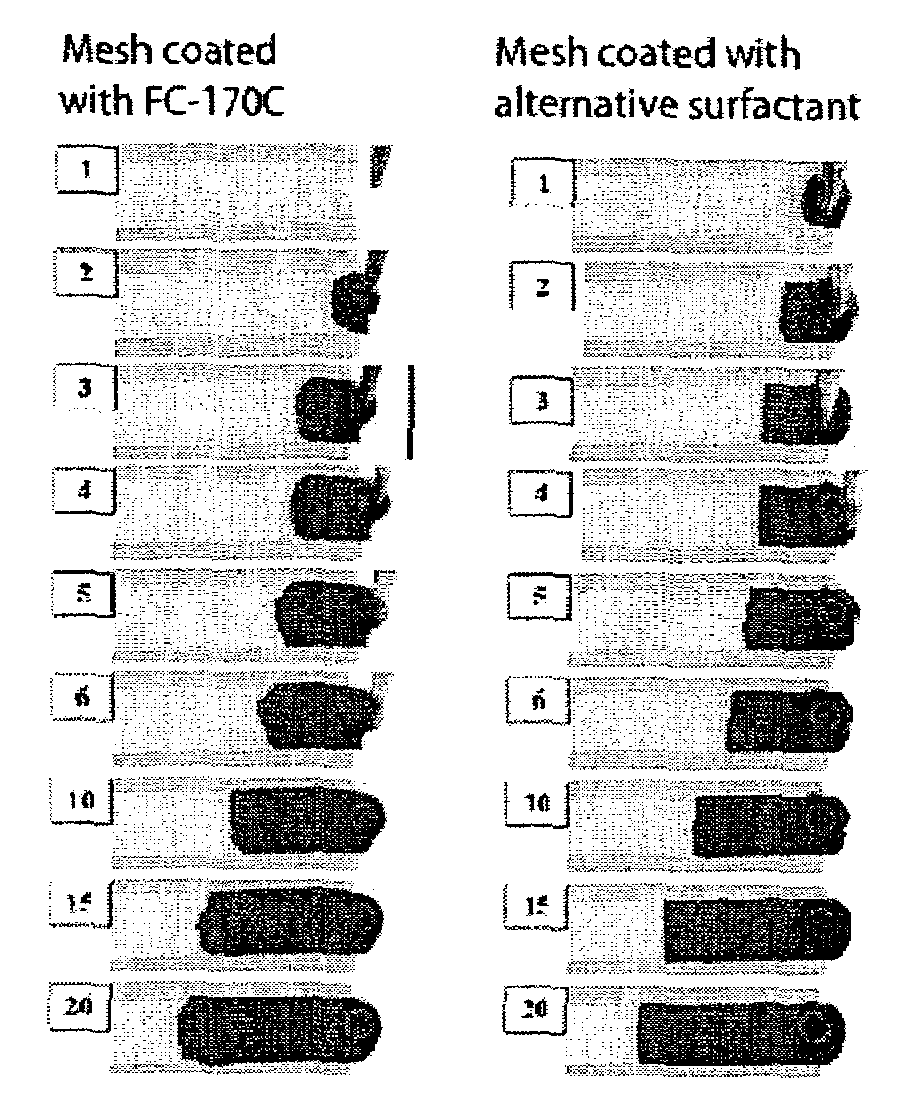Biosensor
- Summary
- Abstract
- Description
- Claims
- Application Information
AI Technical Summary
Benefits of technology
Problems solved by technology
Method used
Image
Examples
example 1
[0113]The purpose of this example was to qualitatively assess the spreading ability of water onto a nylon mesh coated with a surfactant.
[0114]Various types of surfactants (TABLE 2) were coated onto strips of nylon mesh (15 mm wide, NY151, Sefar, Switzerland). Coating was performed by immersing the mesh in an aqueous acetone solution containing the given surfactant (0.1% w / w). The immersed mesh was then slowly withdrawn from the solution and dried in an oven at a temperature of 50° C. for two days. Two nylon mesh control samples, one uncoated and one coated with the surfactant FC-170C, were employed.
[0115]Short lengths of mesh coated with the various surfactants were sandwiched between a polyester sheet and a transparent polyester film by means of a tape having both major surfaces thereof coated with an adhesive (double-sided adhesive tape). This arrangement provided a model sample chamber with a height of approximately 180 to 190 μm, as measured by a micrometer.
[0116]Colored water (...
example 2
[0118]The purpose of this example was to qualitatively assess the spreading ability of blood onto a nylon mesh coated with a surfactant.
[0119]Model sample chambers were constructed using nylon mesh from Example 1 that had been coated with the surfactants that were successful in spreading water (TABLE 3). Again, two nylon mesh control samples, one uncoated and one coated with the surfactant FC-170C, were employed.
[0120]Short lengths of mesh coated with the various surfactants were sandwiched between a polyvinyl chloride (PVC) sheet overprinted with a silver / silver chloride ink and a transparent polyester film by means of double-sided adhesive tape. This arrangement provided a model sample chamber having a height of approximately 180 μm, as measured by a micrometer. The use of a hydrophobic silver / silver chloride layer on the surface of one side of the model sample chamber was intended to reproduce more closely the environment within a typical commercially available sample chamber.
[01...
example 3
[0123]The purpose of this example was to qualitatively assess the spreading ability of blood onto a nylon mesh coated with surfactants, where the nylon mesh is incorporated into a biosensor having two layers of mesh.
[0124]Biosensors substantially similar to those described in U.S. Pat. No. 5,628,890, incorporated herein by reference, were constructed. The biosensors contained a working electrode, an electrode that performs as a reference electrode and a counter electrode, and a trigger electrode. The sample chamber of the biosensor contained two layers of nylon mesh, both of which were coated with surfactant. The layers of nylon mesh were designated NY64 and NY151, both supplied by Sefar (Switzerland). A dip-coating technique was used to coat separate rolls of each type of mesh with the various surfactants being evaluated. TABLE 4 shows the identity and amount of surfactant coated on each layer of mesh.
[0125]Freshly drawn venous blood (5 μl) was applied by automatic pipette (Gilson)...
PUM
| Property | Measurement | Unit |
|---|---|---|
| Fraction | aaaaa | aaaaa |
| Fraction | aaaaa | aaaaa |
| Mesh size | aaaaa | aaaaa |
Abstract
Description
Claims
Application Information
 Login to View More
Login to View More - R&D
- Intellectual Property
- Life Sciences
- Materials
- Tech Scout
- Unparalleled Data Quality
- Higher Quality Content
- 60% Fewer Hallucinations
Browse by: Latest US Patents, China's latest patents, Technical Efficacy Thesaurus, Application Domain, Technology Topic, Popular Technical Reports.
© 2025 PatSnap. All rights reserved.Legal|Privacy policy|Modern Slavery Act Transparency Statement|Sitemap|About US| Contact US: help@patsnap.com



